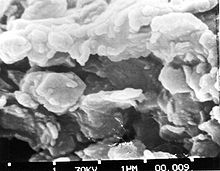Clay
Some of the earliest pottery shards have been dated to around 14,000 BCE,[7] and clay tablets were the first known writing medium.
[8] Clay is used in many modern industrial processes, such as paper making, cement production, and chemical filtering.
Between one-half and two-thirds of the world's population live or work in buildings made with clay, often baked into brick, as an essential part of its load-bearing structure.
In agriculture, clay content is a major factor in determining land arability.
[1] The defining mechanical property of clay is its plasticity when wet and its ability to harden when dried or fired.
The clay mineral kaolinite is transformed into a non-clay material, metakaolin, which remains rigid and hard if moistened again.
Further firing through the stoneware and porcelain stages further recrystallizes the metakaolin into yet stronger minerals such as mullite.
In some clay minerals, the plates carry a negative electrical charge that is balanced by a surrounding layer of positive ions (cations), such as sodium, potassium, or calcium.
[14] The chemistry of clay minerals, including their capacity to retain nutrient cations such as potassium and ammonium, is important to soil fertility.
However, clay soils are often more fertile and can hold onto nutrients better due to their higher cation-exchange capacity, allowing more land to remain in production rather than being left fallow.
[9][10] Clay minerals most commonly form by prolonged chemical weathering of silicate-bearing rocks.
)[17] The clay minerals formed depend on the composition of the source rock and the climate.
Acid weathering of feldspar-rich rock, such as granite, in warm climates tends to produce kaolin.
Primary clays form as residual deposits in soil and remain at the site of formation.
Clays are used for making pottery, both utilitarian and decorative, and construction products, such as bricks, walls, and floor tiles.
[7] Cooking pots, art objects, dishware, smoking pipes, and even musical instruments such as the ocarina can all be shaped from clay before being fired.
[8] Clay was chosen due to the local material being easy to work with and widely available.
[26] Scribes wrote on the tablets by inscribing them with a script known as cuneiform, using a blunt reed called a stylus, which effectively produced the wedge shaped markings of their writing.
[27] Clay is used in many industrial processes, such as paper making, cement production, and chemical filtering.
[34] Between one-half and two-thirds of the world's population, in both traditional societies as well as developed countries, still live or work in buildings made with clay, often baked into brick, as an essential part of their load-bearing structure.
[35] Studies in the early 21st century have investigated clay's absorption capacities in various applications, such as the removal of heavy metals from waste water and air purification.







